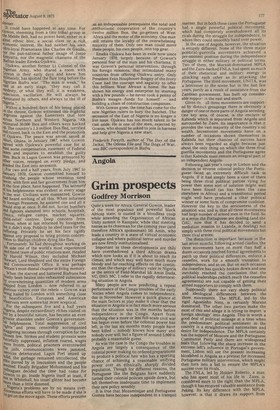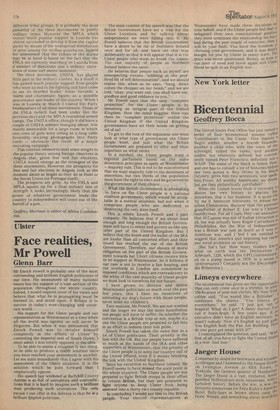Angola
Grim prospects
Godfrey Morrison
Quite a week for Africa. General Gowon, leader of the most populous and powerful black African state, is ousted in a bloodless coup while attending the Organisation of African Unity summit in Kampala; while that meeting names as its chairman for the coming year (and therefore Africa's spokesman) Idi Amin, who leads a country in a state of virtual economic collapse and where political terror and murder are now firmly institutionalised.
Important as these developments are thy have overshadowed a third African drama which now looks as if it is about to reach its climax, and which may well have much more bloody and far-reaching effects on the contin ent than the change of military ruler in Nigeria or the antics of Field-Marshal Idi Amin Dada, VC, DSO, MC. I refer to the rapidly deteriorating situation in Angola.
Many people are now predicting a repeat performance of the Congo troubles of the early 'sixties when Angola comes to independence, due in November. However a quick glance at the main factors at play make it clear that the situation in Angola is in fact much more serious than the situation was in the months before independence in the Congo. Apart from anything else a more or less full-scale civil war has begun even before the colonial power has left; in the last six months many people have been killed — nobody knows how many and nobody ever will, but a figure of around 5,000 is probably a reasonable guess. As was the case in the Congo the troubles in Angola are largely a consequence of the colonial power making no ordered preparations to produce a political heir who has a sporting chance of achieving a reasonable unifying power over an ethnically sharply divided population. Though for different reasons, the Portuguese like the Belgians have suddenly turned their colonial policies upside down, but left themselves inadequate time to implement their new policy sensibly.
It is true that Mozambique and Portuguese Guinea have become independent in a tranquil manner. But in both these cases the Portuguese had a single powerful political movement, which had completely overshadowed all its rivals during the struggle for independence, to whom they could smoothly hand over power.
In the case of Angola, however, the situation is entirely different. None of the three major political/guerrilla movements achieved a pre-eminent position during the independence struggle in either military or political terms. Two of them, the Marxist-dominated MPLA and the Zaire-backed FNLA, had spent as much of their rhetorical and military energy in attacking each other as in attacking the Portuguese. The third movement, UNITA, was a latecomer to the scene but in the last few years, partly as a result of assistance from the Zambian government, has built up considerable suppor in the east and south.
Given ti-u all three movements are suppcirted by distinct groupings there is obviously a danger of one or more parts of Angola seceding. One key area, of course, is the enclave of Kabinda which is separated from Angola and surrounded by Zaire. Its importance is that it provides the vast majority of the country's oil wealth. Secessionist movements have on a number of occasions shown themselves in Kabinda but their chances of success have always been regarded as slight because just about the only thing on which the three rival guerilla movements and the Portuguese agree is that Kabinda must remain an integral part of an independent Angola.
Following last year's coup in Lisbon and the decision to reverse colonial policy the Portuguese faced an extremely difficult task in Angola. If it had simply been a case of there being three rival political parties vying for power then some sort of solution might well have been found (as has been the case elsewhere in Africa) and a transitional period might well have produced a clear political winner or some form of compromise coalition. However the key to the seriousness of the situation was, and is, that all three movements had large number of armed men in the field. So in a sense the Portuguese are dealing (and the OAU, now that it has decided to send a mediation mission to Luanda, is dealing) not -simply with three rival political movements but three rival armies.
The distinction is important because in the last seven months, following armed clashes, the three movements have on more than half a dozen occasions reached formal agreements to patch up their political differences, enforce a ceasefire, work for a smooth transition to independence, and so on. But on each occasion the ceasefire has quickly broken down and one inevitably reached the conclusion that the political leaderships (which reach the ceasefire agreements) are not capable of getting their armed supporters to comply with them. Supposedly there are very sharp political and ideological differences between the three movements. The MPLE, led by the ngid Agostinho Neto, is certainly Marxist dominated. The Other two parties Make the most of this and allege it is trying to import 'a foreign ideology' into Angola. This is worth a good deal of political mileage at a time when the predominant political sentiment in the country is a straightforward nationalism and desire for independence. The MPLA certainly has the support of Moscow and the Portuguese Communist Party and there are widespread fears that following the sharp increase in the extreme left's influence in Portugal's government, Lisbon will use the present increasing bloodshed in Angola as a pretext for increased Portuguese military intervention, which might then turn into a bid to ensure the MPLA's success over its rivals.
The FNLA, led by Holden Roberto, a man who has spent most of his life in Zaire, is considered more to the right than the MPLA, though it has received valuable assistance from Peking. Its key difference with the MPLA, however, is that it draws its support from different tribal groups. It is probably the most powerful of the three movements in purely military terms. However the MPLA which enjoys much popular support in Luanda has almost succeeded in driving it from the capital partly by means of the widespread distribution of arms among the civilian population. Irtdeed my assessment that the climax of the drama ' may be at hand is based on the fact that the FNLA are currently marching on Luanda from a number of directions and a military showdown of some sort seems imminent.
The third movement, UNITA, has played little part in the military clashes. As a result it has gained much popular support from people who want an end to the fighting and have. come to see its bearded leader, Jonas Savimbi, a warm and charismatic figure, as a possible peacemaker and leader of the country. When I, was in Luanda in March I visited the Party headquarters of all three movements. Those of the FNLA (which had been under fire the previous day) and the MPLA resembled armed camps. The UNITA office, though it did have a couple of UNITA soldiers lounging about, was mainly memorable for a large room in 'which two rows of girls were sitting at a long table feverishly sticking photographs into Party cards — obviously the result of a major recruiting campaign. This contrast seemed to lend some weight to the popular theory among foreign observers in Angola that, given free and fair elections, UNITA would emerge as the strongest of the three movements. However the prospects for free and fair elections in Angola look at the moment about as bright as they do in Haiti or the Soviet Union (or Portugal itself).
The prospects are grim, As the FNLA and MPLA square up for a final military test of strength it looks increasingly likely that the power of whatever government leads the country to independence will come out of the barrell of a gun.
Godfrey Morrison is editor of Africa Confidential.



































 Previous page
Previous page